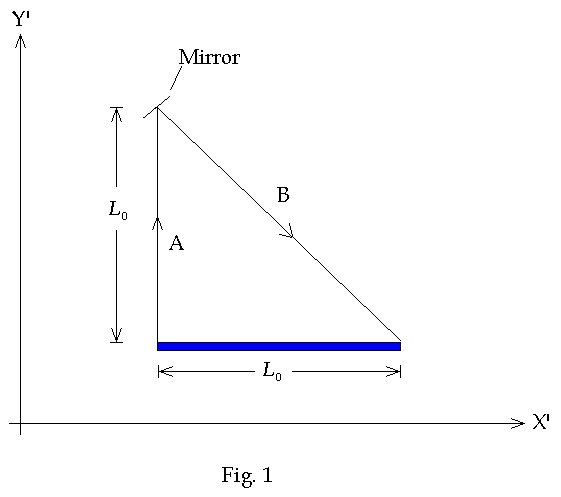
Lorentz
Contraction – Version 2
Back
to Physics World
Back to Special Relativity
A rod is
at rest in the inertial frame of reference S’. A light emitter is located on
one end of a rod and a light detector is located at the other end of a rod. The
emitter emits a continuous laser beam to a mirror which is at rest in S’ and
located as shown in Fig. 1 below.

After
the light is reflected from the mirror it strikes the detector at the other end
of the rod. S’ moves in the +x
direction with speed v with respect to the inertial frame S’. S and
S’ are in standard configuration. The laser beam can be thought of as composed
of a stream of photons. As viewed from S the system appears as in Fig. 2 below.
The mirror is omitted for clarity.

The
velocity transformation relations between S and S’ are given by
![]()
![]()
The
emitter-mirror beam will be referred to as beam A and the mirror-detector beam
will be referred to as beam B. The components of the velocity of the photons in
frame S’ along beam A are

In frame
S the components of the velocity of the photons of beam A in frame S are

Along
beam B the components of the velocity of the photons in frame S’ are

In frame
S the components of the velocity of the photons of beam A in frame S are

The time
it takes for a photon to go from emitter to mirror is tA
while the time for a photon to go from mirror to detector tB.
These times are related to the velocities above as

The time
between emission and detection is therefore mirror is t = tA
+ tB.
The distance from the location the light is emitted to the location that the
light is detected is therefore
![]()
This
distance is the length, L, of the moving rod plus vt, the distance
traveled by the end of the rod during the flight time of the photons. That is
![]()
Solving
for L gives
![]()
Substituting
the values from above gives

Therefore
since g
> 1 it follows that a moving rod is shorter than the same rod at rest.